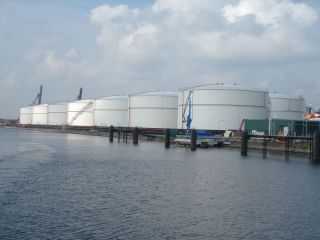Fixed roof tanks
![]() is designing and building fixed roof tanks (with and without steel cup) for all applications and storage products. Here, the different requirements and design parameters are taken into account such as:
is designing and building fixed roof tanks (with and without steel cup) for all applications and storage products. Here, the different requirements and design parameters are taken into account such as:
- Design codes: EN, EEMUA, DIN, API, ASTM, ASME, BS, Codres, etc.
- Applications: chemicals, petroleum, food, H2O, liquefied gases
- Material: carbon steel, stainless steels, etc.
- Temperature range: from -200 °C to +300 °C
- Design pressure: of from atmospheric to about 1.000 mbar
- Specific gravity: of less than 1000 kg/m³ to 2,000 kg/m³ and heavier
- Sizes: of small and factory-made tanks with 100 m³ content to large storage tanks with 70,000 m³ content and more
- Tank bottom: Flat bottom overlapped or butt welded, full overlay or with grillage, performed with and without gradient or as a cone bottom
- Tank roof: self-supporting domed- or cone-roof or ALU -Dome
- Floating roof: Full contact pontoon floating roof equipped with the JPM floating roof seal SWING II
The necessary safety equipment for trouble-free operation of different operating applications are selected and dimensioned by our engineers according to the relevant standards:
- Irrigation as a cooling system for protection against fires of neighbouring structures
- Foaming system as a fire extinguishing system for fighting fires
- Different internal and external heating systems to control the temperature of the stored products
- Over-and under -pressure devices to provide protection against pressure damage
- Overfill prevention (High Level, Low Level)
- External inspection facilities e.g. stairs, ladders, platforms, etc. to ensure safe accessibility of safety- and operating-equipment as well as measurement devices.
- Facilities for inspection of the tank interior such as manholes and cleaning openings
- Roof and tank shell nozzles for different applications and in various designs e.g. double-walled
- Equipment for leakage monitoring of tank bottom and tank shell.
- Tank anchorages according to the designed pressure range and the applicable seismic loads and in accordance with the available foundations
- Additional equipment required for the safe operation e.g. infeed equipment, dip tubes, floating suction units, skimmers, etc.






